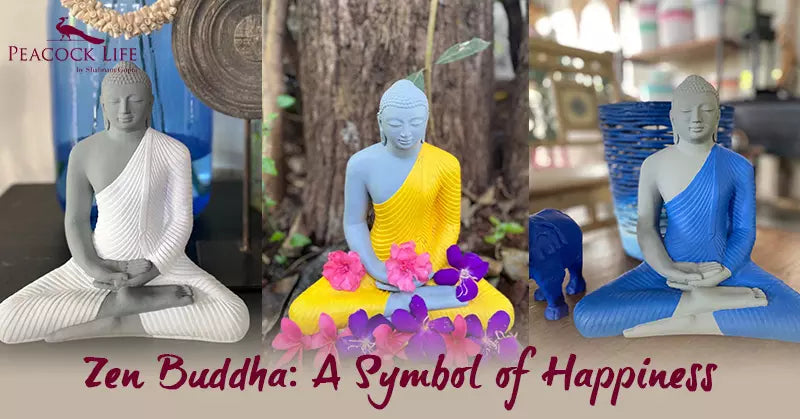
Zen Buddha: A Symbol of Happiness
Peacock LifeShare
Zen Buddha is a symbol of enlightenment, balance and inner peace. According to Vastu Shastra and Feng Shui, the statues of Zen Buddha are the harbingers of auspiciousness and good fortune. According to Vastu, placing Buddha statues at different places in the house can affect your mental health and harmony. Buddha statues invite a positive vitality when placed in the proper position at home.
Zen Buddha And His Places in The House

Zen Buddha is the 'enlightened man' and the founder of Buddhism. Feng Shui and Vastu recommend placing his idol at home to increase spirituality and harmony. Buddha statues add an aesthetic appeal and, when appropriately placed, bring prosperity, good health and peace. The seated Buddha is the most widely recognised depiction. Hand gestures are fundamental in understanding what a sitting Buddha means. Here are the most common forms of the Buddha and their exact location at home.
Buddha Statue for Home:

Vastu Tips for Types and Location of Buddha Statue" width="501" height="303". The sleeping/lying or Nirvana Buddha statue marks the last moments of Shakyamuni Buddha and shows him supporting his head with his right hand. The idol depicts the benevolence that comes with enlightenment and possible liberation from the cycle of rebirth. The lying Buddha illustrates the harmony that people should seek in their lives. Sleeping Buddha should face west for peace in the house.
Medicine Buddha Statue for Home

Buddha's medicine is generally preferred by people seeking good health. The idol's right hand is facing down, fingers are extended towards the ground, the palm is out, and the left hand holds a bowl of herbs. The right hand represents the blessing of the Buddha. Medicine Buddha is about healing the mind, as well as the body, and creating healing energy. Many healing Buddhas are blue and often have lapis lazuli stones. Keep it in a bright area in the living room to be blessed with protection from ill-health.
The head or face of Buddha is a common artefact often used to decorate homes. The Buddha's head is a modern anatomical form. It is a symbol of his self-knowledge. The Buddha's head is the perfect decoration piece for the living room or entryway. The ideal position for placing a Buddha statue is above eye level.
Laughing Buddha is not Gautama Buddha. It is believed that he was a 10th-century Chinese monk named Budai. The Laughing Buddha statue prevalent in most homes reminds us to remove obstacles and be happy in life. Although it is a symbol of Feng Shui, it is also encouraged by the practitioners of Vastu Shastra to install a Laughing Buddha statue in the home. For good luck, keep it in the east direction. Or place it on a corner table, diagonally opposite or towards the main door, to activate the energy entering through the house's main entrance and clear the unwanted energies. Make sure the idol is facing inside the room. To bring prosperity to the family, keep it in the southeast direction.
Do's and Don'ts of Buddha Statues for Home Vastu
- According to Vastu of house, never keep the idol of Lord Buddha directly on the floor or in the safe.
- The idol can be placed on a marble slab, altar table, stone base or small mat. You can also set it on red cloth or paper, as feng shui considers red to symbolise good luck and protection.
- Keep the Buddha at or above eye level. Please do not place the idol where one's feet are pointing towards it.
- Always keep the area around the idol clean. Light incense sticks or candles to purify the air around the idol.
- Avoid Buddha statues in the bedroom, bathroom or kitchen. Avoid placing it near electrical outlets or equipment or on a shoe rack. Ensure the idol is not under the ladder as it can become a Vastu defect.
Zen Buddha Statues
Zen Buddha Lace White

Nothing spells calm, and tranquility like a Buddha figurine does. It's a great addition to your décor, both indoor and outdoor.
Zen Buddha Sunshine Yellow

Zen Buddha is handcrafted with robes in 5 magnificent colours - rust, fiery orange, sunshine yellow, lace white and royal blue. Slight colour variations may happen as the resolution for each screen is different. It's a great addition to your décor, both indoor and outdoor.
Zen Buddha Royal Blue

In the setting that of Zen Buddhism, the perfection of nondiscriminatory wisdom is a signification for the practical, experiential understanding. Nothing evokes peace and tranquility as the Zen Buddha Royal Blue statue does. It's a wonderful decoration for both outdoor and indoor.
Zen Buddha Fiery Orange

Zen Buddha is handcrafted with robes in these magnificent colours - fiery orange, sunshine yellow, lace white and royal blue.
Frequently Asked Questions:
Where Should I Put The Buddha Fountain In The House?
The best place for Buddha Water Fountain is the north of the house. North-east and east harmonies with the water element.
Can I Keep The Statues of Zen Buddha In The Bedroom?
Keeping an idol of Buddha in the bedroom should be avoided. It goes against the principles of meditation and calmness, which are enshrined in the idol.
In Which Direction Should Buddha Face In The House?
The Buddha statue should be facing east. You can also place it in the North-East direction to stimulate the energy of the corner. The lying Buddha should face west.

